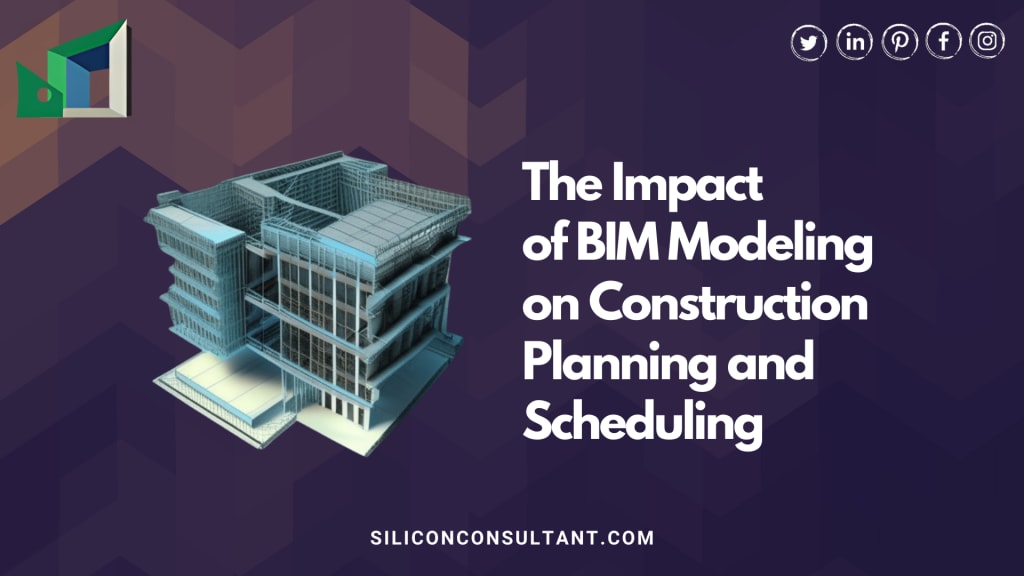The Impact of BIM Modeling on Construction Planning and Scheduling
Learn How BIM Expedite You Project Scheduling

Building Information Modeling (BIM) has emerged as a game-changer in today's rapidly evolving construction industry, revolutionizing how projects are planned and executed. BIM Virtual Design And Construction digitally represents a building's physical and functional characteristics, incorporating 3D modeling, data-rich information, and collaboration tools. This blog explores the transformative impact of BIM modeling on construction planning and scheduling, enabling construction professionals to streamline processes, enhance collaboration, and achieve efficient project outcomes.
Traditional Construction Planning and Scheduling
In the traditional construction landscape, planning and scheduling were largely manual processes. Architects, engineers, and contractors relied on 2D drawings and physical models, leading to numerous challenges and limitations. Key issues included miscommunication, conflicts, and delays due to the need for a comprehensive project view. Additionally, time-consuming and error-prone manual scheduling often resulted in cost overruns and missed deadlines. However, these challenges have been significantly mitigated with the introduction of 3D BIM modeling.
BIM Modeling in Construction Planning
BIM plays a pivotal role in construction planning by revolutionizing the pre-construction phase. Its ability to create a 3D model of the building enables stakeholders to visualize the project more effectively, resulting in improved decision-making and design coordination. The benefits of early BIM integration during planning include the following:
- Clash Detection and Coordination: BIM's clash detection feature identifies and resolves clashes among building elements, such as pipes and ducts, minimizing on-site conflicts and rework.
- Enhanced Collaboration: BIM fosters seamless collaboration among architects, engineers, contractors, and other stakeholders, promoting real-time updates and shared access to project data.
- Improved Project Outcomes: Early BIM integration allows teams to identify potential issues and conflicts, improving project outcomes and reducing change orders.
Impact of BIM on Construction Scheduling
One of the most significant advantages of BIM in construction planning is the integration of time and cost information, leading to 4D and 5D scheduling.
- 4D Scheduling: BIM enables 4D simulations, integrating time into the 3D model. This allows project teams to visualize the construction process over time, identifying potential sequencing issues and optimizing schedules. 4D Modeling helps rectify costly scheduling delays.
- 5D Scheduling: By adding cost data to the 4D model, BIM enables 5D scheduling, providing accurate cost estimation and budget management. This aids in cost control and ensures project financial success.
Enhanced Collaboration and Communication
BIM fosters collaboration among project stakeholders, ensuring everyone is on the same page throughout the construction process. Key benefits include:
- Real-time updates and shared access to project data
- Reduced delays and conflicts due to improved communication
- Streamlined decision-making and issue resolution
Improved Project Visualization and Simulation
BIM's 3D visualization capabilities enable project stakeholders to understand the design and construction process more effectively. Additionally, 4D and 5D simulations offer the following advantages:
- Accurate visualizations of construction sequencing and progress
- Identification of potential issues and conflicts in advance
- Better-informed decision-making based on real-time simulations
Clash Detection and Conflict Resolution
BIM's clash detection feature significantly reduces conflicts and rework during construction. It identifies clashes among building elements, such as pipes, ducts, and structural components, before they become on-site issues.
Resource and Material Management
BIM supports efficient resource allocation and material management, minimizing waste and optimizing resource usage. This data-driven approach enhances cost-effectiveness and sustainability.
Time and Cost Savings
The overall impact of BIM on construction planning and scheduling translates into significant time and cost savings. Projects are delivered more efficiently and within budget with streamlined processes, improved collaboration, and accurate simulations.
Addressing Challenges in BIM Implementation
While BIM offers immense benefits, its successful implementation may encounter some challenges. Construction professionals can overcome these obstacles by:
- Investing in comprehensive BIM training and education for the team
- Emphasizing effective data management and data sharing protocols
- Collaborating closely with BIM service providers for expert support and guidance
Future Trends of BIM in Construction Planning and Scheduling
BIM will likely witness further innovation in construction planning and scheduling as technology advances. Emerging trends include:
- Enhanced use of Artificial Intelligence (AI) for automated scheduling and predictive analysis
- Integration of Internet of Things (IoT) devices for real-time project monitoring and data collection
- Cloud-based BIM solutions for seamless collaboration among geographically dispersed teams
Conclusion
The impact of building information modeling on construction planning and scheduling cannot be overstated. BIM has revolutionized the construction industry, from improved collaboration and communication to enhanced project visualization and simulation. Construction professionals who embrace BIM technology gain a competitive advantage, delivering projects more efficiently, cost-effectively, and with improved project outcomes. The transformative potential of BIM continues to shape the construction landscape, empowering teams to achieve excellence in planning, scheduling, and project execution.
About the Creator
Celia Sieber
My name is Celia and I'm a passionate advocate for all things related to the Architecture, Engineering, and Construction (AEC) industry. read my other blog - https://siliconecllc.weebly.com/






Comments
There are no comments for this story
Be the first to respond and start the conversation.